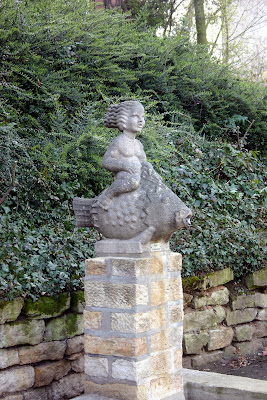The first thing we saw, arriving at the city, was the old train station. The building is very old, impressive and ornamented. Unfortunately, not renovated. They are re-modelling the platforms, but the building is not in the best of shapes. It also houses a restaurant.

Of course, one goes to Worms for its rich medieval history. So off we were to the famous Dom, the Cathedral of Worms (more for it in a separate post). Dedicated to St. Peter, it is one of the finest examples of Romanesque architecture in Germany. Its imposing figure can be seen from afar above the city buildings.

Just before going to the Dom, we saw this cute statue in a nearby park:

The Worms city museum is situated in one of the most beautiful buildings in Worms: the St. Andreasstift, a late Romanesque complex with a picturesque courtyard. You are welcomed by the shady cloister and you can begin a tour through the centuries along the Roman gravestones which were all found in Worms.

One of the strangest things there was a fascinating bird sculpture placed on the grass within the cloister - I wish I could have taken it home with me!

The area has settlements already from the Neolithic period, as the many exhibits in the Worms City Museum show. There is even a type of vessel called Worms. Below you can see typical metallic jewellery found in graves of the period.
 Rich in Roman remains, one can see many references to the era in the museum such as these helmets.
Rich in Roman remains, one can see many references to the era in the museum such as these helmets.
 The old St. Andreas church is now defunct and used as an art exhibition hall. The Romanesque basilica has three naves and a straight (“Worms”) chancel railing and was the chapter church of the Andreasstift (stift means monastery). The church architecture shows forms of the early 13th Century. Gothic changes can be seen in both the church and the adjoining cloister. When I visited, there was a show by an artist making small sculptures of sports figures. They looked nice!
The old St. Andreas church is now defunct and used as an art exhibition hall. The Romanesque basilica has three naves and a straight (“Worms”) chancel railing and was the chapter church of the Andreasstift (stift means monastery). The church architecture shows forms of the early 13th Century. Gothic changes can be seen in both the church and the adjoining cloister. When I visited, there was a show by an artist making small sculptures of sports figures. They looked nice!

There was this little girl sculpture too, totally unrelated to the rest of the artwork, both in colour, size and theme. They included it probably because it fit the former church space.

Leaving the museum, I saw an empty nest resting on an old building stone in the cloisters.

Part of the old city walls is located near the museum - with a main gate no less.

Near Andreasstift is one of the oldest churches in Worms, Magnuskirche (St. Magnus church). Originally it was a Carolingian one-room church, built in the 8th/9th Century. The foundations show both Romanesque and Gothic extensions (in the position of the tower) as well as renovations following the destruction of 1945. The former parish church became the starting point of the evangelical movement in Worms in 1521 and counts as one of the oldest evangelical churches in south west Germany.

I don't know why but I really loved this small church. Maybe it's small size, it's history or the simplicity of the inner decoration (mostly modern now, and minimal since it is Evangelical) are all reasons for this preference. The fact is it felt so serene and calm being inside, without it having anything to do with any religious stuff.

Typical German decoration, always good to see such detailed handiwork:

See and read more about Worms in part two of this tour!
No comments:
Post a Comment